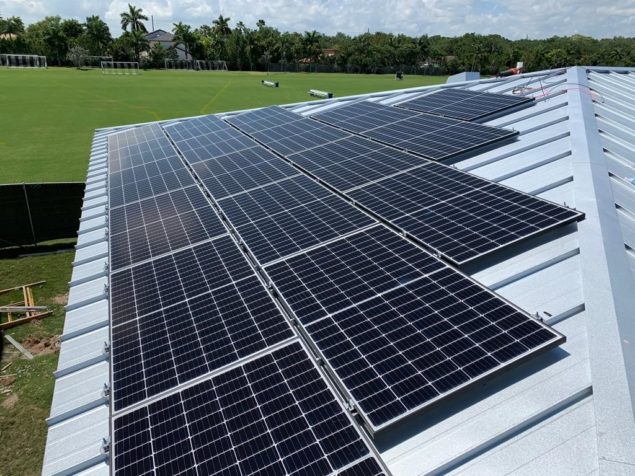
Palmer Trinity School and Goldin Solar recently announced the completion of a 14.625 kW solar Photovoltaic (PV) installation at the new Kipp Field House. The project consists of 45 Hanwha Q-Cell 320-watt monocrystalline panels and the SolarEdge optimizer and inverter system.
“The system was installed by Palmer Trinity as part of our environmental stewardship program,” said Patrick Roberts, head of school.
The mission of the program is:
To educate and empower students to embrace an environmentally healthy, socially just, and economically viable lifestyle.
To create replicable models of how schools can engage their entire community around implementing innovative and economically viable solutions that build a healthier, more sustainable campus.
To reduce the school’s carbon footprint in the short term and achieve carbon neutrality in the long term.
To this end, the system serves as a display for students to learn about solar power, how it works and how important the technology is for our planet’s future. In addition, the carbon footprint of the building is offset because the building’s energy consumption is supplied by the solar panels mounted on its roof.
The panels selected have an uplift pressure rating of 4,000 pascals (industry standard is 2,400) to better resist the high winds required in Florida hurricane conditions. In addition, 60-cell panels were selected instead of 72-cell panels because a smaller panel footprint means a stronger panel.
The inverter is the device that converts the power that the panels produce (DC) to the power that the building can use (AC). It is also the brains of the system and the interface with the grid. The SolarEdge inverter used by Goldin Solar has an additional device included in the system called a DC Power-Optimizer, which is installed under each panel.
This system allows users to monitor the energy production of the system and the energy produced by each individual solar panel. This is helpful for long term care of the system because if one single component is down, it can be immediately observed. The system also allows a higher amount of sunlight to be converted to usable power.
In addition to the standard inverter production monitoring, the system received consumption monitoring equipment. Meaning the online system not only shows the energy produced by the solar system; it shows the consumption of the building. This way users can view how much of the solar power was used immediately by the building, and how much of it was exported to the grid. Conversely, they can see how much of the building’s usage is provided by the solar panels and how much of it was imported from the grid.
Dr. Leopoldo Llinas, director of Environmental Stewardship stated, “The PV system is not only a great opportunity for a greener school, but is a great educational opportunity for students. The school intends to collect data from the solar panels via the online monitoring platform. Teachers and students will have access to this data, which can then be used to compare various other facets of energy expenditure.”
As of Jan. 7, the environmental benefits of the solar panels installed were approximately 16,000 pounds of CO2 saved. This is the equivalent of 400 trees planted. Palmer Trinity and Goldin Solar are proud to lead the way to a brighter future.
For more information about Palmer Trinity School, visit www.palmertrinity.org.






Comments are closed.